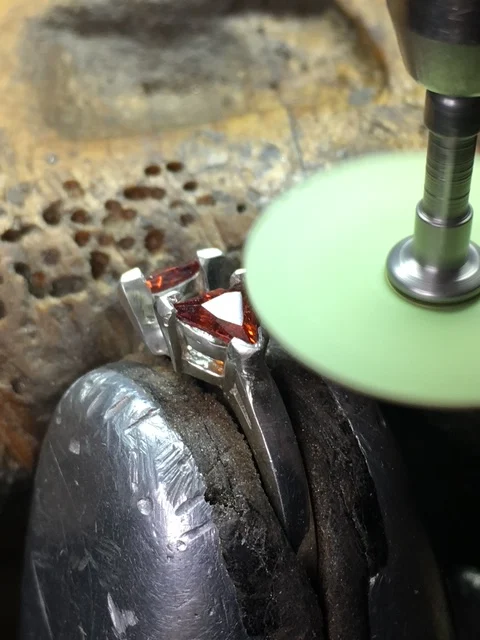I've been thinking 'Why should I wait for days to answer my question 'How was this beautiful brooch made?" I had only one photo to describe this process, but after spending 65 years in Diamond Setting, I did find this quite 'easy' to explain.
It is 'easy for me' but for the vast majority of the blog readers, this might be a real challenge, or literally impossible to say the least.
When I was writing this essay I was thinking about what techniques would I use. It was like I was setting this brooch myself, the time in his essay was easily measured in DAYS.
======================================
1) There will be no large metal 'round-ball clamps' to hold the individual (estimated) 19 pieces. I would use my shellac stick as my first and only choice to hold each section. I want my 'hands and fingers' to have full access to the setting processes.
2) What tools would I use? The answer is just the basic Onglette-shaped gravers #1 and #2. The right side of this graver is meant to be used to create a sheen in the cutting. This is the reason why I name this a "Right-Sided, Onglette Graver". You can't buy these, but they can be made only on your bench.
On the sides of the graver should be well polished to a very high lustre. This will necessitate bright engraving all through the metal carvings.
3) How were the precious multitude of diamonds set into the metal? I would fashion the tip of an additional Onglette graver to be rounded. This rounding allows the graver to be fashioned into a "Bead-Raising tool". This prevents the tip from breaking when forming the gold over every diamond.
4) The jeweller and I will act as a 'TEAM' in the soldering together the many pieces. This discussion is about which section goes where and when.
5) The decision as to which size of diamond goes where is also very important. At each point, the 'leaf' will have one diamond. That one stone must be slightly larger than any others in every section.
6) The Baguettes are another (minor) problem. All of them are 'Straight Baguettes' which means that all of them are sitting in the main stem of the 'flower'. There will be very few 'tapered stones' except for 'the point of the stem'.
7) To avoid a wide stem of Baguettes, this setter chose to engrave a 'double line' along the full length of the brooch's branch. The diamond setter even (very carefully) Milgrained the long metal stem.
This showed me that he had a very delicate hand in using his Onglette graver #1. It was a good choice for the setter's hand dexterity.
In this exquisite metal cutting, accuracy is paramount in shaping and forming the graver blades.
8) There was a fair amount of time spent choosing which Baguette went where.
9) The largest of the Baguettes went into the long stem. The largest of the stones were first set at the base of the long stem. Gradually the smaller stones were next placed into the metal.
10) The 'eye of the wearer' gravitates towards the larger of the 'leaves'. Then the largest of the small diamonds goes into these two leaves. NON-STOP PLANNING AND CONTEMPLATING. Which diamond goes where, when & why?
11) There would be no time spent to think of doing a fast setting. I, or another setter would contemplate spending two weeks or three on this project.
12) Which of the diamonds would get set first? I, for one, would find the largest of the diamonds and place it at the 'tapering of the leaf'.
13) Have each diamond lowered gently into the metal. The 'girdle' of every diamond MUST NEVER BE AT THE SAME LEVEL AS THE METAL. The deeper each diamond is set in the 'Beading Raising' process, the more metal will hold each stone.
This is my Bead Raiser, which shows the slightly rounded shape of the graver's front, or point.
The well-prepared Bead can now be seen as it is well over the edge of the Girdle of the gemstone. The bead MUST BE PERFECTLY CREATED, if it isn't then the stone is not secured.
14) 'Burnish each bead' after every stone is set! This is what a 'Bead Burnisher' looks like.
DO NOT ATTEMPT TO LEAVE ANY FLAT SPACES IN BETWEEN EACH DIAMOND.
15) If there are any spaces, I found that "nature doesn't like to see flat spaces in ornamental flowers". I used a simple method of 'raising decorative beads' and just then 'brushing, or rubbing' all of those beads smoother. The results are just fantastic!!!
There are times when too many beads are used & created. The next alternate step is to use a mini-round bur and make 'little shallow recesses' into the metal. (as shown)
%20(1).jpg)

%20(1).JPG)
.jpg)
.jpg)
%20(1)%20(1).JPG)

%20(1).JPG)
.jpg)

.JPG)
.jpg)
.jpg)


.webp)









.JPG)


.jpg)
.jpg)
.jpg)










.jpg)
.jpg)
.jpg)

.jpg)

.JPG)

.jpg)
.jpg)
